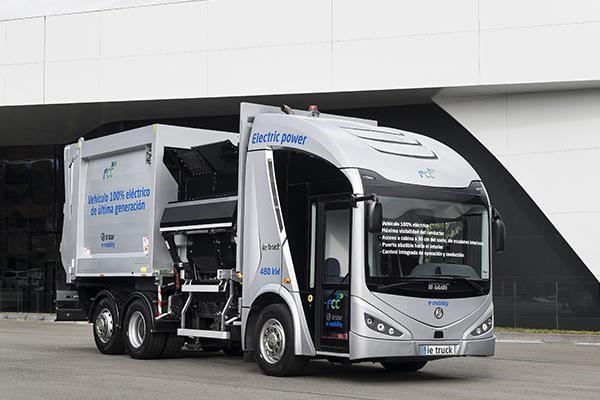FCC Environment and Irízar present the first e-mobility platform for Urban Services
- The first platform with operator cab for 100% electric heavy-duty vehicles, created specifically for Urban Services and with the capacity to deliver non-stop work, wihas been presented at the Smart City Expo World Congress in Barcelona
- It reduces the energy consumed by over 50% when compared to conventional vehicles and also drastically reduces emissions and CO2.

FCC Medioambiente (the Spanish brand for FCC Environment) and Irizar e-mobility presented the first e-mobility platform for Urban Services at the Smart City Expo World Congress, the leading smart environmental solution event. The vehicle is the result of an ambitious technological innovation project, VEMTESU (‘Highly Efficient, Electric-Powered Vehicular, Modular and Self-Supporting platforms for Urban Services’) developed over the past four years in a consortium led by FCC, with the participation of another four benchmark companies of the Spanish market and two external collaborators, all of which are very relevant in the automotive sector and in scientific-technical and electrical-electronic technology areas.
The project is jointly funded by the European Regional Development Fund (FEDER), in the 2014-2020 Operational Programme for Smart Growth, sponsored by the Ministry of the Economy and Competitiveness through the Centre for Industrial Technological Development (CDTI).
100% electric, plug-in, self-recharging and recyclable
The technical details of this innovative technology have been unveiled by the Director of Technical Services of FCC Medio Ambiente, Alfonso García, and by the Managing Director of Irizar e-mobility, Héctor Olabegogeaskoetxea.
Alfonso García highlighted that "The main purpose of FCC in this project is to focus on the development of a fully urban and electric vehicle, with the versatility required in relation to types of bodywork and power needs, designed with a new modular chassis structure and permanent electric drive, as well as a very-low operator cab, moved forward and with a panoramic view, to improve ergonomics and facilitate the execution of services, with built-in bodywork and chassis controls. The driving framework is made up of an electric traction motor, high-power batteries and a unified electronic system".
Hector Olabegogeaskoetxea stated that "the global vision of Irizar Group on the electrification of cities has allowed us to present this innovative lorry today, which features state-of-the-art solutions, in terms of its design, safety and electrical technology, which will operate on cities and urban environments with zero atmospheric and acoustic contamination levels.
It features the group's technologies, such as electric traction, energy storage and control electronics, as well as all other systems supplied. Without a doubt, this project has a promising future”.
The vehicle is equipped with side loading bodywork to collect waste. The 100% electric Plug-in technology means that the lorry drives out of the depot with the batteries fully charged and completes the service in a fully electric mode, therefore, operating as a ZEV vehicle (Zero-Emission Vehicle). If the operating time needs to be extended, it uses a thermal/compressed natural gas (CNG) motor, which is solely used to charge the batteries. This auxiliary motor operates at a constant rate in its maximum efficiency point, achieving the minimum energy consumption and lowest possible emission level. Therefore, the vehicle's batteries are charged during the trip to and from the waste treatment plant, after which the vehicle can start a new shift, if required. As an alternative, the vehicle can be designed to operate in the full-electric mode or be driven by an H-cell (hydrogen).
As a result, the services currently provided by conventional waste collection units can be carried out with the same performance features but with a reduction of over 50% of the energy consumed and a drastic reduction of emissions and CO2.








